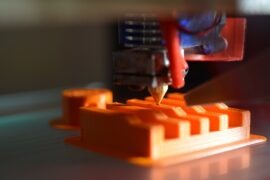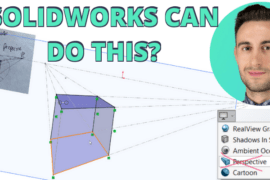
If you do any rendering or use SolidWorks and their PhotoView 360 rendering product, you’re probably familiar with Luxology. They’re the makers of modo, the all-in-one modeling, sculpting, rendering and animation program. They also have a hand in the PhotoView 360 development.
Rendering a model in PhotoView 360 is simple, but limited. You have a lot more power in modo, but getting it all set up for rendering requires a few more steps. This quick guide will get you started down the right path and allow you to experience some of the initial adjustments you’ll want to make when creating a rendering using modo. Let’s rock that model.

SolidWorks to modo
The process of going from SolidWorks to modo in itself, really, could not be easier.With modo 401 you can open a SolidWorks part or assembly directly in modo and we all know there’s nothing especially difficult about opening a file. It’s after that when everything can seem a little foreign. However, the first step is to…
- Open the SolidWorks File in Modo

Simple. Just go to File, Open. Select the SolidWorks file you want to render and select Open. - Change Static Meshes to Mesh

SolidWorks files come in as a Static Mesh. To be able to select polygons, go to the right column, and in the Items tab viewport, Ctrl-select each grayed-out item, right-click and choose Change Type, Mesh. - Add Some Ground

From the left-hand side toolbox, Hold Shift and select Plane. Hit the W-key and use the arrows to move the plane up or down, if necessary. Back on the Items tab rename the Plane item to ‘Ground’ then select the Properties tab below and adjust the X and Z Scale to extend beyond your object, ex. 1000%. - Delete Imported Materials

Currently, it’s easier to apply materials within modo. (See note below on the future of modo and SolidWorks.) First remove the materials brought over from SolidWorks. Go to the upper right column again and select the Shader Tree tab, Ctrl-select each item with a red dot and hit Delete. - Adjust the Environment

In the same Shader Tree tab, select Render (purple sphere icon.) In the Properties tab below the Shader Tree, select Global Illumination along the right side. Set Ambient Intensity to 0.0 and click to enable Indirect Illumination. Select the Environment Material below that and change Environment Type to Physically-based Daylight. - Add Materials

To add a material, hit the 3-key on the keyboard for Polygon select mode. Double-click the object you want to add a material to and hit the M-key for Material. Type a name. Do this for each part that needs a material. - Set Materials

Below the top menu, select the Render tab. Select the Shader Tree tab in the right column again. Materials have a red dot icon. Select one, then go to the left column and browse for a material. Double-click to apply it to the item.
A few material additions and camera tweaks and your rendering will start to take shape.

Things to Note
Y-Up
Modo is a Y-up modeler, meaning the Y-axis points up. Fortunately, the default SolidWorks templates are also Y-up. If you haven’t design your model in the Y-up position, not a problem. You can change the modo coordinate system (System, Preferences, Accuracy and Units) with a single click. You can also put your model into a new SolidWorks template and reorient it in the Y-up position.
Moving Around in modo
In modo, there are view tools in the upper right of the camera viewport to help you rotate, pan and zoom. Using the mouse and keyboard, however, is different from SolidWorks. Rotate the model with the Alt-key and left-click. Pan with Alt-Shift. Zoom in and out with Alt-Ctrl or with the mouse scroll wheel.
SuperGroups and Replicators
SuperGroups and Replicators are created when a SolidWorks file is opened in modo. If there is only one instance of a component brought in, it is grouped together with other parts into one mesh item called a SuperGroup. If there are multiple instances of a component (a patterned part for example) a Replicator is created. They help save time applying materials as well as memory processing time. To prevent SuperGroups from being created, you can follow this quick How-to article on how to import SolidWorks files without SuperGroups.
Items and Shader Tree Viewports
The Items list and Shader Tree are equivalent to the FeatureTree in SolidWorks. If you’re familiar with Photoshop layers, the Shader Tree will make more sense, as each item acts a layer that overrides the other items below it. Each item you select has a corresponding Property tab with other setting that show up below.
Modo Forums
Modo has a strong community and there are a lot of SolidWorks users that frequent the modo forums. If you do a search for SolidWorks, you’ll likely find someone who has had the same questions.
The future of modo and SolidWorks
If you work between SolidWorks and modo a lot, you’re in for a treat coming up in the near future. Part of the process above will be very simplified and working with materials is going to be much easier overall. Ideally material you apply in SolidWorks or PhotoView360 would show up in modo. If I were you, I’d assume that’s going to be possible. Also, when modo 401 was released, SolidWorks 2010 hadn’t been release, so there’s a plugin that’s undergoing testing right now to make this happen. As each program matures and PhotoView 360 gets more features the link and capabilities between these programs seems like it will be stronger.
The Audi R8 SolidWorks Model
That’s a juicy looking model of an R8 isn’t it? Well, you can read more about the R8 Tutorial here and get it yourself and learn a little bit about how to model surfaces in SolidWorks right here.








![6 Types of Civil Engineering Drawings [Detailed Guide]](https://www.solidsmack.com/wp-content/uploads/2023/12/Civil-Engineering-Drawings-270x180.jpeg)

